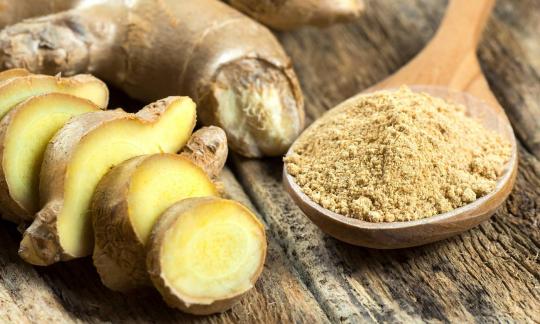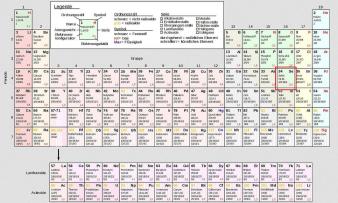Table of contents
Ground ginger ( Zingiber officinale) is a component of many spice mixtures. It is obtained by grinding dried ginger root ( organic). Depending on the drying process, the powder is still raw
Cooking Uses
Ginger powder is a versatile spice that can be used for culinary and medicinal purposes. Alternatively, finely grate fresh ginger can be used to replace the powder.
Ginger has the property of enhancing the flavor of dishes and is used to add spiciness. The 6-gingerol it contains is considered a preservative and flavor enhancer. 2,3 The drying and processing result in losses of the essential oils, so that the smell and aroma of the ginger powder are generally weaker than that of the raw root. 21 You can read about spiciness in the chapter Industrial Production.
Add a pinch of ground ginger to soups, vegan stews and sauces to create a more intense, warm and spicy taste. Ginger can also be incorporated into sweet recipes. Whether cookies, cakes or bread - the ginger powder adds freshness with a slight spiciness. You can also flavor desserts with candied ginger, similar to dried fruit (e.g. raisins). Smoothies also benefit from the refreshing ginger powder. A small amount gives the healthy drink a special kick.
With ground ginger and a little creativity, you can make various homemade spice blends. For inspiration: Combining it with cumin, coriander, turmeric and cinnamon makes curry. Or, mix ginger powder with cinnamon, nutmeg and cloves for a pumpkin pie spice. If you then add cardamom, anise, fennel, coriander and orange peel (organic!), you get a gingerbread spice. Our recipe tip: raw vegan Elisen gingerbread.
You can also use ginger powder in the kitchen as a so-called "functional" spice. Adding a little ginger powder to meals helps to promote digestion and reduce inflammation in the body.
your
How can you make own ground ginger? Cut the ginger into small pieces or thin slices. The thicker the pieces or slices, the longer it takes to dry. You don't need to peel organic ginger unless the root is already very ripe and fibrous. A gentle process is necessary to preserve the ingredients and the taste in raw food quality. This means: protected from sunlight and at a maximum of 40 °C. At higher temperatures you must expect a loss of aroma. With a dehydrator it takes around 7 hours for the ginger to dry. Check the moisture level every now and then. Once the ginger is completely dried, you can grind it into raw ginger powder using a mortar or spice grinder.
Vegan recipe for ginger-orange pumpkin soup
Ingredients (for 2 servings) : 500 g organic Hokkaido pumpkin, 100 g carrots, 1 onion, 1 clove of garlic, 1 teaspoon organic ginger (ground; ~ 5 g), 200 ml oat cream, 200 ml vegetable stock, 2 oranges (organic), salt,pepper, pumpkin seed oil (for garnishing).
Preparation: Preheat the oven to 200 degrees. First wash the Hokkaido pumpkin thoroughly (you eat the skin too) and then cut it in half. Scrape out the seeds with a spoon. Then cut into eighths and slice about 2 cm thick. Also cut the carrots, onion and garlic into large pieces and bake everything together for 25 minutes. Meanwhile, squeeze the juice from the oranges. As soon as the vegetables are ready, put all the ingredients in a large pot and mix with a hand blender. Serve the vegan soup lukewarm, drizzling with pumpkin seed oil if necessary.
Tea preparation
Pour hot water over a teaspoon of ginger powder and add lemon juice and honey if necessary as soon as the liquid has cooled down a little (this way the valuable ingredients from the juice and honey are better preserved). Then you can enjoy the spicy ginger tea.
Vegan recipes with ginger powder can be found under the note: " Recipes that have the most of this ingredient ".
| Not only vegans or vegetarians should read this: Vegans often eat unhealthily. Avoidable nutritional mistakes. |
Purchasing - Storage
You can find ginger powder in most supermarkets such as Coop, Migros, Denner, Volg, Spar, Aldi, Lidl, Rewe, Edeka, Hofer, Billa, Denn's Biomarkt or Alnatura. Health food stores, drugstores and online shops also offer ginger capsules as a dietary supplement and ginger paste in addition to the spice. Organic quality is often found.
The availability of ground ginger varies depending on the size of the store, catchment area, etc. Our recorded food prices for the DA-CH countries can be found above under the ingredient image - and by clicking you can see their development at various suppliers.
Storage tips
Store ginger powder in a well-sealed, airtight container in a dry, cool and dark place: it will then last for up to a year. After that, ground ginger loses its aroma.
Ingredients - Nutritional values - Calories
Here we realistically show you the ingredients of spices and herbs per 1 g (instead of per 100 g as usual).
1 g of ground ginger contains hardly any fat or protein, but 0.72 g of carbohydrates (of which 0.14 g are fiber). The powder provides 3.35 kcal of energy per 1 g. 1
Manganese, iron and selenium are the most important essential nutrients that ginger powder offers. However, due to the small amount consumed, they and the macronutrients do not contribute significantly to meeting the respective daily requirement (with the exception of manganese, see below). The secondary plant substances in this ingredient are far more important for its health value. Since all herbs and spices have many health-promoting ingredients, we deliberately avoid the term superfood here.
Manganese can be found in dried ginger at 0.33 mg/1g. One teaspoon covers most of the manganese requirement. Saffron and cardamom contain similarly high amounts. Cloves have almost twice as much manganese content. 1
We recommend that you cover your selenium intake with Brazil nuts or whole grain products such as kamut or wheat.
The complete ingredients of ginger powder, the coverage of the daily requirement and comparison values with other ingredients can be found in our nutrient tables. In the article Nutrients explained you will get a detailed insight into the topic.
Health Effects
Is ground ginger healthy? Whether fresh ginger or powder - both have health benefits.
Secondary plant substances
Our article on secondary plant substances provides an overview of the classification of substance groups, their occurrence in foods and possible effects on humans. Ground ginger contains the following secondary plant substances, among others:
- Isoprenoids: Monoterpenes (including limonene, citral, geranial, neral, alpha phellandrene, ar-curcumene, p-cineole [eucalyptol], alpha-terpineol, camphene, beta-myrcene); triterpenes (steroids); Sesquiterpenes (alpha-zingiberene, farnesene, nerolidol) 4,5,25,26,27
- Alkaloids: Phenyl alkaloids 4
- Polyphenols: hydroxycinnamic acids (ferulic acid), flavonoids: flavonol (quercetin); phenols (gingerdiol, gingerol, shogaol, paradol, zingerone, gingerone A, gingerone B) 5,6,23
- Other organic compounds: arylalkanones, diarylheptanoids (curcuminoids) 6
However, it should be noted that the composition of the secondary plant substances in ground ginger can vary depending on the variety, time of harvest and growing conditions. Therefore, quantities are only of limited use and should only be understood roughly.
So far, over 160 health-promoting components of ginger have been isolated and identified. Of these, 20 are known to be phenolic compounds, such as flavonoids, the sesquiterpenes and paradols. The secondary plant substances in ginger offer numerous health benefits. They have anti-inflammatory, antioxidant, anti-tumor, anti-diabetic and pain-relieving effects. These compounds support heart function, lower blood sugar levels, prevent blood clotting and protect against cell damage. Ginger is therefore used for complaints such as arthritis, muscle pain, digestive disorders, high blood pressure and infectious diseases. 5,8
Is ginger good for the liver? In cases of damage caused by alcohol, galactosamine or carbon tetrachloride, ginger can have an antihepatotoxic effect (against liver toxins); the liver's antioxidant activity improves when ginger is taken. 6
Studies on ginger powder show positive effects in the treatment of common migraine attacks. 5 In cases of nausea and vomiting associated with chemotherapy, an alleviation of symptoms was observed when ginger powder was administered. 9 However, there are also studies that found no improvement in symptoms. 4
To produce ground ginger, the water must first be removed from the root. This is done using heat. The corresponding heating or dehydration products of the pungent substances in the fresh root (gingerols) are shogaols and, in smaller amounts, zingerones (vanillylacetones). 23 Shogaols are only present in trace amounts in fresh ginger, but are found in high amounts in thermally treated ginger roots. They are said to have stronger bioactive properties than gingerols and to have increased antioxidant, anti-inflammatory, antimicrobial and anticarcinogenic effects. 16,17,23 Data also suggest that 6-shogaol plays an important role as a memory-enhancing and antioxidant agent against neurological diseases. 16,23
The quality of ginger powder can vary greatly depending on the production method, drying method, storage, etc., which also affects the health effects (more on this in the chapter Industrial Production). There are studies that show that the antioxidant effect of ginger varies depending on the processing stage. Dried ginger has the highest antioxidant capacity, followed by fried and carbonated ginger (fresh ginger with mineral water). This is due to the higher levels of phenolic compounds in dried ginger. Fresh ginger, on the other hand, has the lowest antioxidant capacity. Heating or storage converts gingerols into shogaols, which affects the antioxidant capacity. 25
What is the ideal dosage for ground ginger? The recommended dose for digestive problems is 2-4 g of ginger powder daily. In connection with motion sickness in adults and children over 6 years of age, 0.5 g can be taken half an hour before the trip and then 2 to 4 times a day (up to 4 g daily). During pregnancy, a daily dose of 1-2 g of ginger powder can help against nausea. For rheumatoid arthritis and other inflammatory diseases, 2-4 g of ginger powder per day is recommended. 10
For comparison: For fresh ginger, 10 g is considered ideal (guideline values: usually a little less than 1 cm or a little more than a teaspoon if freshly grated).
A study on the effect of ginger on cataracts shows the following results: Diabetes increases the risk of developing cataracts (hence the study was carried out on diabetic rats). The onset of cataracts is delayed in the groups fed ginger powder compared to the untreated diabetic groups. At the end of the nine weeks, the groups fed ginger were significantly less sick than the untreated rats. In this study, ginger was powdered by freeze-drying and then ground. 8
Dangers - Intolerances - Side effects
Although ginger has hardly any side effects, 4 sensitive people may experience heartburn, headaches or dizziness. 9 The maximum dosage of dried ginger should be less than 6 g/day to avoid gastrointestinal problems; increased intake of ginger can lead to increased erosion of epithelial cells on the stomach surface. 10 However, the amounts should be adjusted individually: Discuss the use of ginger for medicinal purposes with your doctor.
There are also different results as to whether ginger increases the effect of anticoagulant medications or not. 10
Use as a recognized medicinal plant
There are positive monographs on the use of ginger as a drug by Commission E and the Committee on Herbal Medicinal Products ( HMPC : well-established use / traditional use) as well as by ESCOP and WHO. Ginger is used to treat dyspeptic complaints, to prevent symptoms of motion sickness (nausea, vomiting) and to treat nausea during pregnancy (under medical supervision). 6,7
Folk medicine - natural medicine
The use of ginger to treat colds, vomiting, upset stomach, chills and coughs has a tradition going back thousands of years. 4 Ginger is also used in folk medicine for neurasthenia (mental exhaustion), sore throats, urinary retention, abdominal pain and bad breath. 6
Ecological footprint - animal welfare
The ecological footprint of ginger powder depends on several aspects, including the production of fresh ginger, but also the further processing, transport and packaging. The Big Climate Database gives the CO 2 footprint of fresh ginger as 1.85 kg CO 2 eq/kg. 18 Through Due to the additional processing steps and the packaging required, the CO 2 consumption for the production of ginger powder is higher. From an ecological point of view, it is better to consume fresh ginger. However, fresh ginger has a high moisture content (85-90%). This can accelerate fungal and microbial growth on the product and leads to rapid spoilage. Storage losses of ginger are estimated at 50%. 11 Ginger powder has a longer shelf life and reduces losses in fresh products, so production is definitely worthwhile despite the additional work steps.
In conventional agriculture, synthetic pesticides and herbicides are often used to combat unwanted insects or plants. These can sometimes also be found in the end product, as a study of various types of vegetables in Nigeria also showed for ginger. 19 Pesticide residues were also found in ginger powder: 20 So when shopping, look for products from organic farming.
For detailed explanations of various sustainability indicators (such as ecological footprint, CO2 footprint, water footprint), see our article: What does the ecological footprint mean?
Worldwide occurrence - cultivation
The origin of ginger ( Zingiber officinale) is not clear, but it is thought to have originated in Southeast Asia. 6 In China and India, ginger has a cultural history spanning thousands of years and was an important trading item. Over 2000 years ago, ginger was exported from India to the Roman Empire, where it was particularly valued for its medicinal properties. Even after the fall of the Roman Empire in the 13th and 14th centuries, ginger remained a highly sought-after commodity in Europe. In the Middle Ages, ginger was exported in preserved form, for sweets, among other things. Queen Elizabeth I of England is credited with inventing the gingerbread man, which is still a popular ginger Christmas treat today. 12,13
Today, ginger is grown in many tropical regions of the world. In India alone, around thirty different varieties are grown, but Africa, China and South America are also major suppliers of ginger. The origin has an influence on the taste: varieties from Jamaica and India have a slightly lemony aroma, Brazilian ginger has a floral note. 14
Cultivation - Harvest
Information can be found under the ingredient ginger, raw.
Industrial production
There are many ways to produce ginger powder. The first processing step is drying the root. This can be done by simple sun drying, microwave drying or oven drying, among others.
As one study shows, ginger is subject to complex thermal reactions: unlike other vegetables with antioxidant properties, ginger's antioxidant activity is not necessarily lost at elevated temperatures. 24 However, available scientific data do not allow us to say clearly whether thermal treatment increases or decreases biological activity. A literature review 15 suggests that traditional cooking and microwave processing generally reduce the antioxidant activity of ginger rhizomes, while roasting, autoclaving, blanching or traditional drying in the sun usually increase activity significantly. Of all the methods discussed in this review, freeze-drying appears to be the most effective technique for drying ginger rhizomes, as it increased antioxidant activity the most.
The spiciness of ground ginger depends on numerous factors (origin of the rhizome, time of harvest, storage, processing conditions, drying temperatures and methods, etc.); it is difficult to give an average value. Recent research suggests that gingerols (raw root) are spicier than shogaols (dried root), 21 but the issue is controversial.
Whether the ginger can still be described as raw food after the industrial drying process depends on the temperature used. Rhizomes of exotic origin may have been blanched beforehand. 22 It is best to choose a retailer you trust and ask if you are unsure.
Further information
Ginger belongs to the ginger family, which also includes cardamom ( Elettaria cardamomum) and turmeric ( Curcuma longa). The part of the ginger that we consume is called the rhizome. The rhizome is the stem or thickened branch of the plant from which roots and leaves grow. 12 Rhizomes are found underground or just above the surface of the earth. 14
Alternative names
In German, the terms ground ginger or ginger powder (ginger powder) are common. Alternative names for ginger are ingber, imber, immerwurzel and ginger root. In English, ginger powder is called 'ground ginger' (ground ginger), 'ginger powder' or 'ginger spice'. The drug name is 'Zingiberis rhizoma'.
Bibliography - 27 Sources
| 1. | US-Amerikanische Nährwertdatenbank USDA. 2019. |
| 2. | Dilukshi Vichakshana GA, Young DJ, Choo WS. Extraction, purification, food applications, and recent advances for enhancing the bioavailability of 6-gingerol from ginger – A review. Qual Assur Saf Crops Foods. 22. September 2022;14(4):67–83. |
| 3. | Abd El Hady Mousa M, Mansour H, Eid F, Mashaal A. Anti‐inflammatory activity of ginger modulates macrophage activation against the inflammatory pathway of monosodium glutamate. J Food Biochem. 2021;45(8):e13819. |
| 4. | Zhang M, Zhao R, Wang D et al. Ginger (Zingiber officinale Rosc.) and its bioactive components are potential resources for health beneficial agents. Phytotherapy Research. Februar 2021;35(2):711–742. |
| 5. | Shahrajabian MH, Sun W, Cheng Q. Clinical aspects and health benefits of ginger (Zingiber officinale) in both traditional Chinese medicine and modern industry. Acta Agriculturae Scandinavica, Section B — Soil & Plant Science. 2019;69(6):546–556. |
| 6. | Bäumler S. Heilpflanzenpraxis Heute: Arzneipflanzenporträts. 3. Auflage. München: Elsevier;2021. |
| 7. | Arzneimittellexikon: Ingwer. Kooperation Phytopharmaka GbR. |
| 8. | Saraswat M, Suryanarayana P, Reddy PY et al. Antiglycating potential of Zingiber officinalis [sic!] and delay of diabetic cataract in rats. Mol Vis. 10. August 2010;16:1525–1537. |
| 9. | Kim SD, Kwag EB, Yang MX, Yoo HS. Efficacy and safety of ginger on the side effects of chemotherapy in breast cancer patients: systematic review and meta-analysis. International Journal of Molecular Sciences. 2022;23(19):11267. |
| 10. | Pakrashi SC, Pakrashi A (Hrsg). Ginger: A Versatile Healing Herb. Indien: Vedam eBooks (P) Limited; 2003:36-30. |
| 11. | Malik A, Shimpy, Kumar M. Advancements in ginger drying technologies. Journal of Stored Products Research. Januar 2023;100:102058. |
| 12. | Bode Am, Dong Z. The Amazing and Mighty Ginger. In: Benzie IFF, Wachtel-Galor S (Hrsg). Herbal Medicine: Biomolecular and Clinical Aspects, Second Edition. Vereinigte Staaten: CRC Press. 2011:131-147. |
| 13. | Kumari M, Kumar M, Solankey SS. Zingiber officinale Roscoe: Ginger. In: Novak J, Blüthner WD (Hg.). Medicinal, Aromatic and Stimulant Plants. Cham: Springer International Publishing; 2020:605–621. |
| 14. | Von Au F. Ingwer: Die wunderbaren Heilkräfte der magischen Knolle - Neues über das vielseitige Superfood. Deutschland: Penguin Random House Verlagsgruppe GmbH; 2023. |
| 15. | Zagórska J, Czernicka-Boś L, Kukula-Koch W, Iłowiecka K, Koch W. Impact of Thermal Processing on the Selected Biological Activities of Ginger Rhizome-A Review. Molecules. 2023;28(1):412. |
| 16. | Jung MY, Lee MK, Park HJ et al. Heat-induced conversion of gingerols to shogaols in ginger as affected by heat type (Dry or moist heat), sample type (Fresh or dried), temperature and time. Food Sci Biotechnol. 29. Dezember 2017;27(3):687–693. |
| 17. | Dalsasso RR, Valencia GA, Monteiro AR. Impact of drying and extractions processes on the recovery of gingerols and shogaols, the main bioactive compounds of ginger. Food Research International. April 2022;154:111043. |
| 18. | CONCITO. The Big Climate Database, version 1. Ginger root, raw. 2021. |
| 19. | Olutona GO, Fakunle IA, Adegbola RA. Detection of organochlorine pesticides residue and trace metals in vegetables obtained from Iwo market, Iwo, Nigeria. International Journal of Environmental Science and Technology. 2022; 4201-4208. |
| 20. | Times of Malta. Do not consume this ginger powder [online aufgerufen am 25.08.2023]. |
| 21. | Zachariah TJ. Ginger. In: Parthasarathy VA, Chempakam B, Zachariah TJ (Hg.). Chemistry of spices. CABI Pub. 2008: 70-96. |
| 22. | Heuschrecke com: Trocknungsverfahren für Kräuter und Gewürze (2022). |
| 23. | Ozkur M, Benlier N, Takan I et al. Ginger for healthy ageing: a systematic review on current evidence of its antioxidant, anti-inflammatory, and anticancer properties. Oxid Med Cell Longev. 9. Mai 2022;2022:4748447. |
| 24. | Sueishi Y, Masamoto H, Kotake Y. Heat treatments of ginger root modify but not diminish its antioxidant activity as measured with multiple free radical scavenging (Multis) method. J Clin Biochem Nutr. 2019;64(2):143-147. |
| 25. | Mao QQ, Xu XY et al. Bioactive Compounds and Bioactivities of Ginger (Zingiber officinale Roscoe). Foods. 2019;8(6):185. |
| 26. | Gunathilake KDPP, Rupasinghe HP. Recent perspectives on the medicinal potential of ginger. Botanics: Targets and Therapy. 2015;5:1-18. |
| 27. | El-Ghorab AH, Nauman M, Anjum FM. A Comparative Study on Chemical Composition and Antioxidant Activity of Ginger (Zingiber officinale) and Cumin (Cuminum cyminum). J Agric Food Chem. 2010;58(13):8231-8237. |











Comments